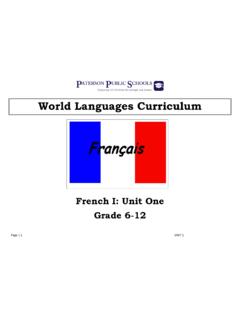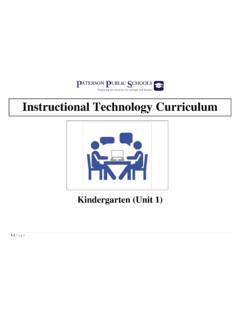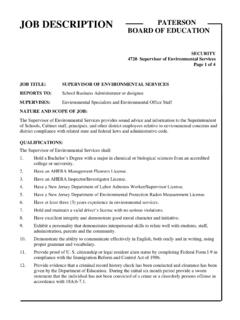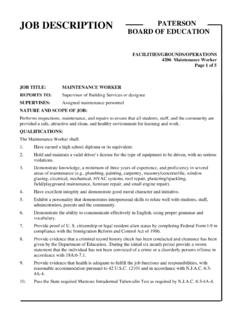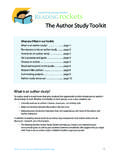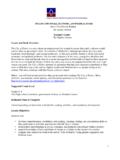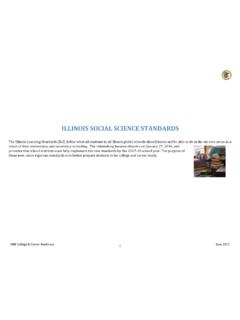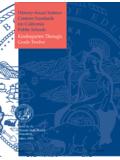Transcription of ENGLISH LANGUAGE ARTS - Paterson School District
1 1 | P a g e ENGLISH LANGUAGE arts ENGLISH III: Unit 3 Reading Literature and Informational Text Informative/Explanatory Writing 2 | P a g e Course Description (Workshop Model) ENGLISH III consists of reading, writing, speaking, listening and media literacy skills. During the block of literacy instruction students will learn to use reading strategies that help them become effective readers. Some of these strategies include questioning the author, inferring, visualizing, synthesizing and learning multiple strategies to help students learn to monitor their reading comprehension.
2 The ENGLISH III curriculum is designed around universal themes and essential questions to promote literary analysis of reading, incorporation of textual evidence when writing and to encourage students to engage in deep meaningful discussions to socialize intelligence. The students are exposed to multiple genres of reading and writing such as fiction, non-fiction, short stories, essays, novels, drama and poetry. Students will compose narrative, informational, expository, persuasive, argumentative, and other pieces of writing required by the teacher.
3 The workshop model is employed so that all students can improve their skills and voice as writers. Teachers will instruct students using the workshop model philosophy with the use of the I DO, WE DO, YOU DO method of instruction. Other skills such as grammar, vocabulary, listening and speaking are infused in the exploration of effective reading and writing. The ENGLISH III course and instruction will lay the foundation for successful achievement in ENGLISH and on the state unit assessments. The New Jersey Student Learning Standards are designed to provide a clear understanding of what students are expected to learn, so teachers and parents know what they need to do to help them.
4 The standards are designed to be robust and relevant to the real world, reflecting the knowledge and skills that our young learners need for success in college and careers. It is our goal to establish a community of learners to become productive citizens in society striving towards pursuing their life-long goals. Through an enriching and rigorous education and with on-going support our students will be fully prepared for the future and to compete successfully in the global economy. 3 | P a g e Rationale In order to plan instruction inclusive of all students in the ENGLISH LANGUAGE arts classroom, a comprehensive curriculum has been developed.
5 The standards covered during each instructional unit of the LANGUAGE arts curriculum are reflective of the New Jersey Student Learning Standards outlined in the New Jersey Curriculum Framework. Each standard in reading and writing has been unpacked to illustrate the critical knowledge and skills students need in order to master the standard. Essential questions and sample activities are included to utilize when teaching such standard. Given the diverse population of learners in the classrooms, the essential elements related to the standards from the Dynamic Learning Maps have been included for the special education students as a means to inform teachers of the learning expectations and outcomes for those students, based on their individual needs.
6 4 | P a g e Pacing Chart Unit 3 Topic: Reading Literature and Informational Texts Narratives and Literary Analysis NJSLS Instruction: 8 weeks Assessment: 1 week District RESOURCES PARCC Writing Unit Literary Analysis Task Where Lovers Dream by Anzia Yezierska Sonnet 120, My Mistress Eyes Are Nothing Like the Sun by William Shakespeare From Sister Carrie by Theodore Dreiser The Grasshopper by Anton Chekhov PARCC Writing Unit Research Simulation Task and Introductory Lesson Origins by Peter Tyson Moon Formation May Have Been the Result of Larger, Faster Planet Collision from RedOrbit What is the Origin of the Moon?
7 By Sarah J. Carmichael One extended text chosen by the teacher The Great Gatsby, Their Eyes Were Watching God, A Raisin in the Sun, Brave New World, The Scarlet Letter, As I Lay Dying, The Things They Carried, In Pharaoh s Army, The Crucible Reading Standards: Literature , , , , , , Informational , , , , , Writing Standards ,B,C,D,E, F, , , , , , LANGUAGE Standards: , ,B, , ,B,C,D, ,B, Speaking and Listening Standards: ,B,C,D, , , , , 5 | P a g e Effective Pedagogical Routines/Instructional Strategies Collaborative problem solving Writing to learn Making thinking visible Note-taking Rereading & rewriting Establishing text-based norms for discussions & writing Establishing metacognitive reflection & articulation as a regular pattern in learning Quick writes Pair/trio Sharing Turn and Talk Charting Gallery Walks Whole class discussions Modeling Word Study Drills Flash Cards Interviews Role Playing Diagrams.
8 Charts and graphs Storytelling Coaching Reading partners Visuals Reading Aloud Model (I Do), Prompt (We Do), Check (You Do) Mind Mapping Trackers Multiple Response Strategies Choral reading Reader s/Writer s Notebooks Conferencing 6 | P a g e Educational Technology Standards , , Technology Operations and Concepts Produce and edit a multi-page digital document for a commercial or professional audience and present it to peers and/or professionals in that related area for review. Example: After listening/reading a text, students will choose the best summary of the text out of 3 provided by the teacher.
9 Students have the option of composing their findings and supporting their choice of the best summary, in a digital document, to share with their peers. Students may use PowerPoint, Prezi, Google Slides, etc. Creativity and Innovation Apply previous content knowledge by creating and piloting a digital learning game or tutorial. Example: Students implement concept mapping strategies to determine and track the development of themes throughout a text by noting how each successive event adds complexity or details. Students will use multiple digital tools to create their concept maps.
10 Tools will include, Inspiration, PowerPoint, Prezi, etc. Digital Citizenship Demonstrate appropriate application of copyright, fair use and/or Creative Commons to an original work. Example: When working with multiple texts from the unit, student may follow MLA guidelines when quoting and citing textual evidence to support their ideas and claims. When utilizing images in presentations, students will properly cite the source of the image if copyright laws apply. 7 | P a g e Career Ready Practices CRP1, CRP4, CRP11 CRP1. Act as a responsible and contributing citizen and employee Career-ready individuals understand the obligations and responsibilities of being a member of a community, and they demonstrate this understanding every day through their interactions with others.
